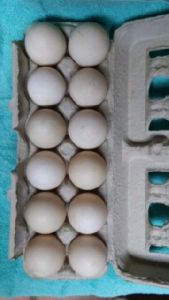
We’ve been in business since 1987 and have sold hatching eggs for the past 15 years. We collect eggs daily, and batch them indoors and catalog them until orders can be freshly packed and promptly shipped. Again, we do NOT have any pure white Muscovy in our bloodline.

We generally offer Muscovy Eggs from January through August, We have Black, Black Pied, Lavender, Chocolate & Buff color varieties in our flock so your eggs may hatch a variety of colors. The eggs you get come from our lovingly raised stock. Ships from our Farm in Tucson, Arizona, United States Shipping only. Our farm is certified USDA Organic, no pesticides or herbicides ever. All our Eggs for hatching are from our proven breeders. Poultry, Waterfowl, Pheasant Hatching Eggs. Eggs For Hatching Fresh Laid, Fresh Collected for every customer. Other names for the domestic breed in Spanish are pato casero (“backyard duck”) and pato mudo (“mute duck”) becasue they do not quack, but more of a muted quack or whisper. Their plumage color is also more variable. They have been bred since pre-Columbian times by Native Americans and are heavier and less able to fly long distances than the wild subspecies. The domestic subspecies, Cairina moschata domestica, is commonly known in Spanish as the pato criollo. In general, Barbary duck is the term used for C. Both sexes have pink or red wattles around the bill, those of the male being larger and more brightly colored.Īlthough the Muscovy duck is a tropical bird, it adapts well to cooler climates, thriving in weather as cold as 12 ☌ (10 ☏) and able to survive even colder conditions. It may have white patches or bars on the wings, which become more noticeable during flight. The amount of white on the neck and head is variable, as well as the bill, which can be yellow, pink, black, or any mixture of these colors. The bird is predominantly black and white, with the back feathers being iridescent and glossy in males, while the females are more drab. Females are considerably smaller, and only grow to 3 kg (6.6 lb), roughly half the males’ size. Size somewhere between a crow and a goose. Muscovies are a large duck, with the males about 76 cm (30 in) long, and weighing up to 7 kg (15 lb). Oh, our eggs are good! These are newly hatched ducklings that will grow up to be tail-wagging ducks that are always happy to see you! Please look at our pics, these are our pets! We do not have any pure white Muscovy in our flock. Feral Muscovy ducks are found in New Zealand, Australia, and in parts of Europe.

Small wild and feral breeding populations have established themselves in the United States, particularly in Florida, Louisiana, Massachusetts, the Big Island of Hawaii as well as in many other parts of North America including southern Canada. Therefore, select a duck egg hatching machine with accurate controls to keep the conditions at optimal levels.The Muscovy duck (Cairina moschata) is a large duck native to South America & Central America. Finally, you need to maintain the humidity, temperature, and airflow inside the incubator at the required levels for efficient egg hatching. Select a machine that is easy to clean to maintain the required hygiene standards for egg hatching. Also, consider the ease of cleaning when settling for an incubator. Choose a duck egg hatching machine within your budget with features fitting your needs. The amount of money you are willing to spend on an egg incubator is another major consideration when purchasing one.

It is essential to settle for a machine that fits the number of chicks you want to hatch. The capacity of the equipment determines the number and the type of eggs you can hatch. Before selecting egg hatching equipment, it is important to consider its egg capacity. These factors include capacity, cost, ease of cleaning, and accuracy of control.

When selecting a duck egg hatching machine for your farm, there are various factors to consider.


 0 kommentar(er)
0 kommentar(er)
